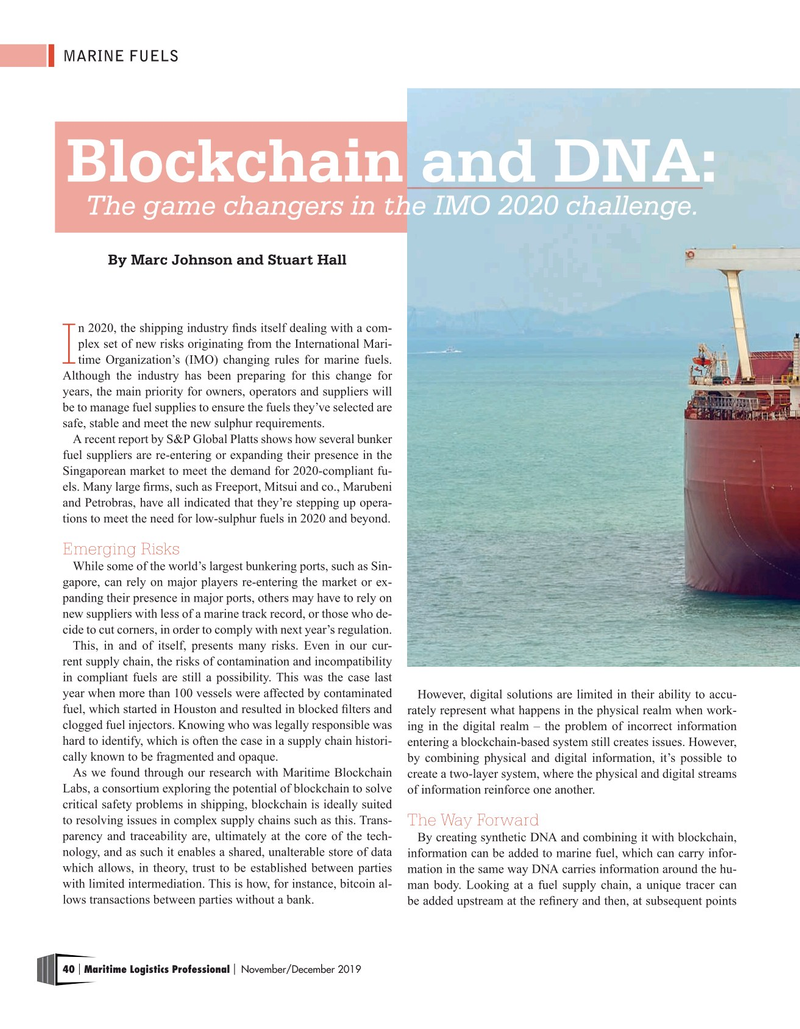
Page 40: of Maritime Logistics Professional Magazine (Nov/Dec 2019)
Short Sea Shipping Ports
Read this page in Pdf, Flash or Html5 edition of Nov/Dec 2019 Maritime Logistics Professional Magazine
MARINE FUELS
Blockchain and DNA:
The game changers in the IMO 2020 challenge.
By Marc Johnson and Stuart Hall n 2020, the shipping industry fnds itself dealing with a com- plex set of new risks originating from the International Mari-
Itime Organization’s (IMO) changing rules for marine fuels.
Although the industry has been preparing for this change for years, the main priority for owners, operators and suppliers will be to manage fuel supplies to ensure the fuels they’ve selected are safe, stable and meet the new sulphur requirements.
A recent report by S&P Global Platts shows how several bunker fuel suppliers are re-entering or expanding their presence in the
Singaporean market to meet the demand for 2020-compliant fu- els. Many large frms, such as Freeport, Mitsui and co., Marubeni and Petrobras, have all indicated that they’re stepping up opera- tions to meet the need for low-sulphur fuels in 2020 and beyond.
Emerging Risks
While some of the world’s largest bunkering ports, such as Sin- gapore, can rely on major players re-entering the market or ex- panding their presence in major ports, others may have to rely on new suppliers with less of a marine track record, or those who de- cide to cut corners, in order to comply with next year’s regulation.
This, in and of itself, presents many risks. Even in our cur- rent supply chain, the risks of contamination and incompatibility in compliant fuels are still a possibility. This was the case last year when more than 100 vessels were affected by contaminated However, digital solutions are limited in their ability to accu- fuel, which started in Houston and resulted in blocked flters and rately represent what happens in the physical realm when work- clogged fuel injectors. Knowing who was legally responsible was ing in the digital realm – the problem of incorrect information hard to identify, which is often the case in a supply chain histori- entering a blockchain-based system still creates issues. However, cally known to be fragmented and opaque. by combining physical and digital information, it’s possible to
As we found through our research with Maritime Blockchain create a two-layer system, where the physical and digital streams
Labs, a consortium exploring the potential of blockchain to solve of information reinforce one another.
critical safety problems in shipping, blockchain is ideally suited to resolving issues in complex supply chains such as this. Trans-
The Way Forward parency and traceability are, ultimately at the core of the tech- By creating synthetic DNA and combining it with blockchain, nology, and as such it enables a shared, unalterable store of data information can be added to marine fuel, which can carry infor- which allows, in theory, trust to be established between parties mation in the same way DNA carries information around the hu- with limited intermediation. This is how, for instance, bitcoin al- man body. Looking at a fuel supply chain, a unique tracer can lows transactions between parties without a bank. be added upstream at the refnery and then, at subsequent points 40 Maritime Logistics Professional November/December 2019 | |

 39
39

 41
41
